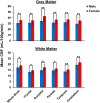Sex and age-related differences in cerebral blood flow investigated using pseudo-continuous arterial spin labeling magnetic resonance imaging
- PMID: 33596183
- PMCID: PMC7950235
- DOI: 10.18632/aging.202673
Sex and age-related differences in cerebral blood flow investigated using pseudo-continuous arterial spin labeling magnetic resonance imaging
Abstract
Adequate cerebral blood flow (CBF) is essential to a healthy central nervous system (CNS). Previous work suggests that CBF differs between men and women, and declines with age and certain pathologies, but a highly controlled systematic study across a wide age range, and incorporating white matter (WM) regions, has not been undertaken. Here, we investigate age- and sex-related differences in CBF in gray matter (GM) and WM regions in a cohort (N = 80) of cognitively unimpaired individuals over a wide age range. In agreement with literature, we find that GM regions exhibited lower CBF with age. In contrast, WM regions exhibited higher CBF with age in various cerebral regions. We attribute this new finding to increased oligodendrocyte metabolism to maintain myelin homeostasis in the setting of increased myelin turnover with age. Further, consistent with prior studies, we found that CBF was higher in women than in men in all brain structures investigated. Our work provides new insights into the effects of age and sex on CBF. In addition, our results provide reference CBF values for the standard ASL protocol recommended by the ISMRM Perfusion Study Group and the European ASL in Dementia consortium. Thus, these results provide a foundation for further investigations of CNS perfusion in a variety of settings, including aging, cerebrovascular diseases, and dementias.
Keywords: MRI; aging; arterial spin labeling; cerebral blood flow.
Conflict of interest statement
Figures





References
-
- Alsop DC, Detre JA, Golay X, Günther M, Hendrikse J, Hernandez-Garcia L, Lu H, MacIntosh BJ, Parkes LM, Smits M, van Osch MJ, Wang DJ, Wong EC, Zaharchuk G. Recommended implementation of arterial spin-labeled perfusion MRI for clinical applications: A consensus of the ISMRM perfusion study group and the european consortium for ASL in dementia. Magn Reson Med. 2015; 73:102–16. 10.1002/mrm.25197 - DOI - PMC - PubMed
Publication types
MeSH terms
Grants and funding
LinkOut - more resources
Full Text Sources
Other Literature Sources
Medical

